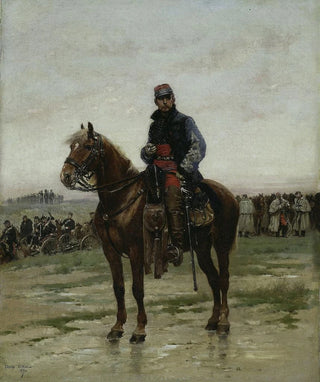Art print | A mounted officer - Jean-Baptiste Édouard Detaille


View from behind

Frame (optional)
Introduction captivante
The artwork "Un officier monté" by Jean-Baptiste Édouard Detaille is a true testament to 19th-century military art, capturing with striking accuracy the spirit of an era when the glory of battles and the heroism of soldiers were celebrated. Detaille, a renowned French painter known for his mastery of military scenes, invites us to immerse ourselves in a universe where every detail matters. The depicted scene is both a tribute to the bravery of men in uniform and an exploration of the nuances of military life, subtly revealing the emotions and tensions present in these moments of glory. The art print of this work allows appreciation not only of the artist's technique but also of the atmosphere emanating from each brushstroke.
Style and uniqueness of the work
The work stands out for its striking realism, characteristic of Detaille's style. The colors, rich and vibrant, seem to come alive before the viewer's eyes, while light plays a fundamental role in the composition. The meticulous details of the uniforms, horses, and landscapes testify to rigorous observation and a deep respect for the subject. Each element is carefully arranged to create a visual harmony that transports the viewer to a specific moment in military history. The artist does not merely depict a scene; he tells a story, that of an officer in full action, symbolizing duty and honor. This immersive approach makes "Un officier monté" a piece of art that is not limited to its surface but invites reflection on the human condition in the face of war.
The artist and his influence
Jean-Baptiste Édouard Detaille, born in 1848, is considered one of the greatest painters of military scenes of his time. His artistic journey is marked by an unwavering passion for history and the representation of soldiers. Detaille managed to establish himself in the art world thanks to his exceptional talent, but also through his commitment to historical accuracy. He witnessed the upheavals of his era, notably the Franco-Prussian War, and was able to translate these experiences into powerful and evocative works. His influence extends to

Matte finish

View from behind

Frame (optional)
Introduction captivante
The artwork "Un officier monté" by Jean-Baptiste Édouard Detaille is a true testament to 19th-century military art, capturing with striking accuracy the spirit of an era when the glory of battles and the heroism of soldiers were celebrated. Detaille, a renowned French painter known for his mastery of military scenes, invites us to immerse ourselves in a universe where every detail matters. The depicted scene is both a tribute to the bravery of men in uniform and an exploration of the nuances of military life, subtly revealing the emotions and tensions present in these moments of glory. The art print of this work allows appreciation not only of the artist's technique but also of the atmosphere emanating from each brushstroke.
Style and uniqueness of the work
The work stands out for its striking realism, characteristic of Detaille's style. The colors, rich and vibrant, seem to come alive before the viewer's eyes, while light plays a fundamental role in the composition. The meticulous details of the uniforms, horses, and landscapes testify to rigorous observation and a deep respect for the subject. Each element is carefully arranged to create a visual harmony that transports the viewer to a specific moment in military history. The artist does not merely depict a scene; he tells a story, that of an officer in full action, symbolizing duty and honor. This immersive approach makes "Un officier monté" a piece of art that is not limited to its surface but invites reflection on the human condition in the face of war.
The artist and his influence
Jean-Baptiste Édouard Detaille, born in 1848, is considered one of the greatest painters of military scenes of his time. His artistic journey is marked by an unwavering passion for history and the representation of soldiers. Detaille managed to establish himself in the art world thanks to his exceptional talent, but also through his commitment to historical accuracy. He witnessed the upheavals of his era, notably the Franco-Prussian War, and was able to translate these experiences into powerful and evocative works. His influence extends to






